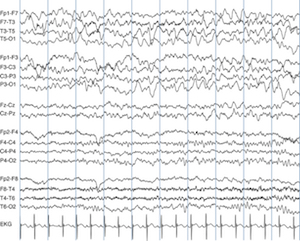This is part one of a two part blog about my story of overcoming epilepsy. I am hoping that it sheds light on the daily struggle of those who have epilepsy, gives hope to others (and their families) that you are not alone, and is helpful in the lessons I have learned and share through my experience. I know that all seizures are NOT the same and that what helped me will not apply to everyone. However, the powerful gut-brain connection IS the same and nutrition plays a huge role in optimum brain function.
 As I felt the blood rush to the surface of my skin and my palms start to sweat, I looked out at a sea of interested faces. It was book report presentation day in the fourth grade and it was my turn. My throat felt tight and the words turned into a stream of stammering. All of a sudden it was like someone pressed pause on the movie of my life, then pressed play a few seconds later. I am not sure what happened in those few seconds between pause and play since everything went black but when play was pressed again, I was still standing in front of the classroom, still giving the presentation. I wasn’t sure how much time had passed but apparently nothing eventful happened since the faces didn’t show any sign of alarm. I felt the pause and play buttons pressed a few more times during my five minute presentation, making my time up there feel like an eternity. When I finished, I heard the clapping of hands signaling that I had successfully given my book report presentation. I slowly took my seat. Nothing was mentioned by my teacher or classmates that anything they saw was out of the ordinary. That day I experienced what I now know to be petit mal seizures.
As I felt the blood rush to the surface of my skin and my palms start to sweat, I looked out at a sea of interested faces. It was book report presentation day in the fourth grade and it was my turn. My throat felt tight and the words turned into a stream of stammering. All of a sudden it was like someone pressed pause on the movie of my life, then pressed play a few seconds later. I am not sure what happened in those few seconds between pause and play since everything went black but when play was pressed again, I was still standing in front of the classroom, still giving the presentation. I wasn’t sure how much time had passed but apparently nothing eventful happened since the faces didn’t show any sign of alarm. I felt the pause and play buttons pressed a few more times during my five minute presentation, making my time up there feel like an eternity. When I finished, I heard the clapping of hands signaling that I had successfully given my book report presentation. I slowly took my seat. Nothing was mentioned by my teacher or classmates that anything they saw was out of the ordinary. That day I experienced what I now know to be petit mal seizures.
Concerned about that day, I asked one of my classmates if he had ever experienced moments where he was speaking to someone and his mind just went blank.
“Yeah, it’s just called a ‘brain fart,’” he said. “Everybody has them.”
Reassured that it was nothing out of the ordinary, I never brought it up again to anyone, not even my parents. After all, there was clearly nothing wrong. I didn’t know to seek out a neurologist, nor did I know what one did.
In addition to this ‘brain fart’ I was also having episodes where I would forget where I was or where I left off in the conversation. Not wanting to draw attention to myself, I quickly learned to adapt. Learning to adapt would be the theme of my life for the next few decades. I would either pretend that I heard everything that was said or would say phrases like, “Can you say that again?” or “What was that?”
Being Diagnosed with Epilepsy
Flash forward to my first year of college at American University. I was in a bit of a slump because I chose my education over a career in dance. Right before I started college I represented the United States in a tap dance competition two years in a row and we won first place! It was the greatest feeling in the world! Then, leaving my channel for self-expression, I started college and I fell into a sadness I had never known. I went to a doctor who prescribed me Wellbutrin (this was before the seizure warnings for this drug were announced).
I was on summer break in Buffalo, NY, just came into the house from driving around and running errands. Suddenly, I felt a little weird. I looked down at my watch and saw that it was 1:00 p.m. I took two steps towards my closet, grabbed the post of my day bed, and my knees started to buckle. That’s the last thing I remember.
When I opened my eyes, I was lying on my side, my nose hurt, and I realized I had wet myself. I looked at my watch and it was 2:00 p.m. Where did that hour go? What happened during that hour? How long was I out for? I looked around and I was lying half in my closet next to my record crate and half in my room. Did I think it was a good idea to take a nap here? I knew that since I wet myself, I must have had a grand mal seizure.
When I stood up I felt pressure thumping loudly in the front of my face. I instinctively tried to put my nose into place where it belonged and heard a loud CRACK. I didn’t have any issues breathing so I didn’t think there was a real problem. Also, I didn’t think I needed to go to the emergency room since I felt okay — a little out of it, but okay. Also, If I did go, what would I say to them? I had no idea what really happened during that hour but all signs pointed to a grand mal seizure. I changed my clothes and went about the rest of the day but didn’t drive, just in case I had another episode.
When I got back to Washington, D.C., I contacted a neurologist to make an appointment. After a series of tests he diagnosed me with epilepsy/generalized seizure disorder. I was 19 years old. I was first put on the medication Tegretol, which I couldn’t tolerate at the adult dose because of my slender weight. Over the years, I went to Topamax, Keppra,

Klonopin, and finally, Lamictal. During this time, nutrition was never brought up and I was never told to change or alter my diet, nor was I given any specific diet to follow. Being in college, I definitely ate more sugar than the veggies I should have, which probably didn’t help my health, but since I was never told to change my diet, I never did. Over the next 11 years, I was given an electroencephalograph (EEG) every four to six months to monitor my brain and seizure activity. No matter what medication I was on, the seizures never seemed to be under control. I always felt like the side effects of the medications caused more issues than they were helping.
The Diet Connection Revealed: My B-Day Trip to Thailand
For my 30th birthday I traveled to Thailand to visit a friend and see the temples. Before I left , my neurologist gave me Klonopin in addition to the Lamictal to help me adjust to the time difference and help me sleep. It did help but made me feel weird. Before I left, I was still having a few (or so I thought) petit mal seizures each day. (Later I learned that I was having many more seizures than I thought.)
During my trip, I was eating many rice-based dishes, along with fresh vegetables, meat (that tasted like how meat should taste), and unprocessed food. I felt INCREDIBLE! I felt like the seizures disappeared completely. I didn’t have any absence episodes. It was life changing!
When I came home, I went back to the foods I was usually eating like pizza, sushi, Thai food, subs, and salads. The first day back, I was so excited to order Thai food during my lunch break at work. I ate a wheat spring roll and within 15 minutes threw it up. I couldn’t understand why I had such a severe reaction after I spent 10 days eating Thai street food and drinking water in Thailand without ANY reactions.
Each time I ate something with gluten in it, I felt tired, like someone drugged my food. I also noticed my stomach felt extremely bloated and I would feel gassy. I also noticed the seizures came back and I felt spacey, like I had brain fog every day. It was horrible!
I then decided there was something to this gluten thing. I scoured the Internet looking for answers like my life depended on it (after all it did). I found out that my symptoms after eating gluten matched gluten sensitivity. I also had a hunch that there was a sugar connection to the seizures since when my blood sugar got low, I had more petit mal seizures. Again, I researched EVERYTHING I could find.
The next appointment I had with my neurologist, I brought up my amazing gluten and sugar connection discoveries, hoping he would share my excitement. After telling him everything that I found and my Thailand, no-gluten and no-seizure experience, he just looked at me and matter of factly said, “You will never be able to control your seizures with diet.” That was it. Nothing more. I was absolutely devastated. I still felt in my bones that he was wrong. There was something more to all of this. There HAD TO BE a nutrition component to epilepsy that he was not aware of. There just had to be. I left his office still on the hunt for this nutrition key. In the meantime, I went gluten-free and started to feel better. The brain fog started to clear and I didn’t feel like someone roofied me each time I ate a bagel or pizza.
Also, at this time I started reading the book Treating Epilepsy Naturally by Patricia A. Murphy, which entailed many stories of children with various types of seizures disorders and how they were helped by nutrition. I KNEW there was a nutrition component. Maybe a ketogenic diet wasn’t the right fit for my petit mal seizures, but a nutrition component existed!
Overdosed on Seizure Meds
Since I could tolerate Lamictal well, I stuck with this medication, but it did not stop me from having petit mal seizures. In search of finding a cocktail of seizure meds to control

the seizures, my doctor kept increasing my dose of Lamictal and then added Keppra, while I was still taking Klonopin. At 135lbs, I was taking the max dose of Lamictal, 800mg/day plus the two other medications. I felt like all this medication was too much for my body to handle.
Suddenly, I started having these episodes in the morning where my vision was like trying to tune in a TV channel using bunny ear antenna. My vision kept flipping, and flipping and flipping. These episodes would last for FOUR hours each morning. They were horrible. I had to carefully move around my house and just hope my vision would return to normal soon. I could only call or voice text on the phone and couldn’t get much done. I tried to adapt the best I could. I still had to go to work and be productive. Not wanting to draw attention to myself, I would ask my co-workers to read some of my work to me so I could still manage to get SOME things done. On the way back home, I would just hold onto the handrails when I was in the D.C. metro so I didn’t fall over or collapse.
I made an appointment at a local D.C. hospital to see if something was happening to me since I really didn’t think it was caused by my medications. What else could be causing this vertigo and these vision changes?
I told the attending physician and resident what I was experiencing with the weird vision issues. They began brainstorming possibilities. I felt like I was on an episode of House. Then the resident looked straight at me, very sure of herself and said, “I think it’s syphilis.” Frustrated, I said to the resident, “It is NOT syphilis!” I felt like I was at my wit’s end. Then the attending physician asked me a question that caused a lightbulb to go off.
“How much time is there between each time you take your medication?” he asked.
I realized that when I took my medication at night, at 1 a.m. when I got home from work, and then when I woke up at 6 a.m., there was only five hours in between for my body, especially my liver, to process all of the medication. I thought this would explain the weird symptoms but he didn’t say anything more. They weren’t completely sure what was going on with me and referred me to my neurologist.
I was on a mission to get to the bottom of this. I contacted my neurologist and his solution was to increase the medication further, but I was already at the max dose. I was never given a blood test to see where my Lamictal levels were. Typically, a blood test is given regularly to see how much Lamictal is in your system. I requested the Lamictal blood test repeatedly but was told by my doctor that one “does not exist.” I knew the test existed since my dad had it done at the Mayo Clinic in Minnesota. (My dad has seizures caused by scar tissue from hitting his head when he was a toddler and is also on Lamictal.)
I was fed up with my doctor. He took me off of Keppra and Klonopin and kept the Lamictal at 800 mg, still the max dose. The seizures got somewhat better but the vision “flipping” was still happening each morning. I then started back on the internet hunt, looking for more answers and a new neurologist.
Answers Found
In my research into these vision flipping episodes, I stumbled upon a thread on Epilepsy.com about a woman who had the same issue with her son. She brought her son to the ER where they checked the level of his Lamictal and discovered he had “Lamictal Toxicity” – too much Lamictal in his system causing a host of side effects, including altered vision and vertigo. THIS IS IT I thought! I must have a toxic level of Lamictal in my system.
Not sure what else to do except decrease the Lamictal on my own (which I DO NOT recommend to anyone without a doctor’s supervision), I cut my Lamictal dose down to 600 mg, instead of the 800mg. The vision flipping episodes stopped. I felt such relief. I also made an appointment with a new neurologist.
Stay tuned next week for part 2!



fascinating and forever inspiring !
will study diligently and truly incorporate the lessons you are teaching !
LikeLiked by 1 person
Thanks so much Marilyn! That means a lot to me! It took me a long time to finally write this story. Thank you for being a part of my journey!
LikeLike
Thank you for telling your story, looking forward to the next part~
LikeLiked by 1 person
Thanks so much Roselynn!!! 🙂 I posted part 2 today!
LikeLike